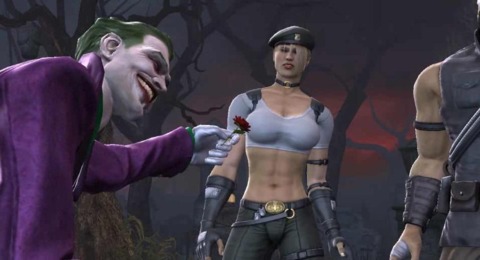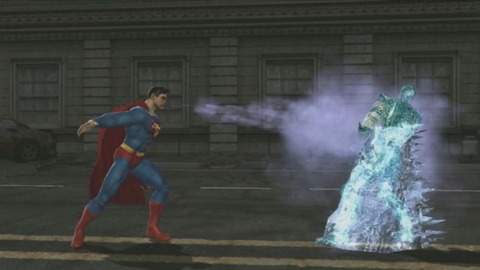
For the second time in series history, the fighting in Mortal Kombat vs. DC Universe has been completely revamped. Most of the features and fighting from the previous three console games has been thrown out. Apart from a pair of characters who are armed with blades, there aren't any weapon stances or style changes to worry about. And the combo system ditches ground-based, memorization-heavy combos in favor of timing-focused juggles, which effectively makes it more like the previous 2D games in the series. While you can still sidestep to avoid projectiles at range, the game has a snappy, classic feel to it without feeling like a throwback. One of the few things that carry over from the more-recent 3D entries in the series is the combo breaker, which will crack you out of a jam if you have enough juice in your super meter to use one. You can store up to two breakers if your meter is full. A full meter also lets you enact rage mode, which makes you attack through an opponent's block and not react when you get hit for a few seconds. It's a neat idea that can be effective when playing alone, but most human opponents seem to know to just get away when you pop into rage.
While the core concept of merging the two worlds together is kind of appealing on their own, it's really the gameplay in Mortal Kombat vs. DC Universe that makes it stand out. There's a steep learning curve to contend with, and the game doesn't really provide many pointers about how to get better. But once you spend time with it and start to pick up on how it all works, it's fantastic. The fighting manages to feel unlike anything else on the market while still retaining enough Mortal Kombat style to make it appealing to players who are familiar with the series' arcade roots. It also seems to work on multiple levels, rewarding players who take the time to learn and master the more difficult combos while never feeling completely alien. Two players with a passing knowledge of fighting games could probably pick it up and have a decent time, but you get the impression that between the different juggles and things like "pro moves," which are enhanced or branched versions of your special moves that often require very precise timing, there's a lot of appropriately rewarding stuff to pick up as you improve. While it may play quite a bit differently than most of the other fighting games coming out today, it still revolves around the classic balance of knowing what moves are available to you while also deciding when to use specific attacks, or how to block incoming flurries from your opponent.

The game has a more elaborate story mode than you'd expect out of a fighting game, and it's largely in place to give you a good reason why the fighters of Mortal Kombat and the tights-wearing set from DC are getting together for a fight. Much like how the Mortal Kombat series is all about the bad guys trying to merge their horrific realm with Earth, a series of events causes Mortal Kombat's Earthrealm to begin merging with DC's universe. This sets everything in both locations topsy-turvy, as everyone's powers fluctuate and characters begin fighting due to an infection known as "kombat rage." Really, this all seems like it's in place to tell you why a ninja like Sub-Zero could harm Superman with his fists, or why Batman and Wonder Woman would face off.
The story is split in half, and you choose if you want the MK side or the DC side at the onset. The two stories run concurrently, so you'll see things referenced in one that take place in the other, and so on. They both culminate in a battle against the creepy merged creature that's causing all of this strife in the first place. Interestingly, you don't choose a character in story mode. Instead, it jumps around, devoting each chapter to a different fighter. This serves the alternate purpose of getting you up to speed on how most of the fighters operate. The story sequences themselves have a laugh here and there, but they're also a little hokey in spots. Then again, I tend to find most superhero stuff a bit hokey, anyway. Of course, there's probably something sort of hokey about a martial arts tournament that determines the fate of the world that is fought by movie stars, demons, ice ninjas, and thundergods, so maybe it all balances out. Either way, it works and the tone of it is just fine.
The game also has a single-player arcade mode, which provides you with the standard MK ladder, culminating in a boss fight and an ending. The endings are in the classic MK style, giving you a couple of static pieces of artwork with some dialogue about what your chosen fighter did after beating the crap out of everyone else. On the practice side of things you can find a standard practice mode and the kombo challenge. This mode gives you ten combos for each fighter that you must complete to succeed. The combos are surprisingly difficult and showcase the tight timing that many of the moves and juggles have. The game doesn't hold your hand at all, which is a bit harsh, especially when you consider that DC fans who don't play many fighters might be coming in only to discover a series of button presses that make absolutely no sense. A proper tutorial and a "show me what this combo you're asking me to do is supposed to look like" button--like the Tekken series has--would have been a good addition.

All of these single-player modes are made better by the game's AI. Unlike most MK games, which had bad pattern-based AI that refused to be thrown or only became susceptible to certain attack patterns, the opponents in MKvDC seem to fight fair and use a variety of tactics. It's a great improvement over most of the previous games to bear the Mortal Kombat name. That said, there's no substitute for human opposition.
You can, of course, play against another person locally. But the game also has online support on both platforms. The player matching is a bit different between the two versions, though. On the 360, you get ranked game and player match options, and unlike most Xbox Live games, there's no "host game" or "join game" options. You just push the "ranked game" button and it finds you someone to play with. Player match works the same way, but you can also just invite friends to join you in these unranked battles. There are also chat rooms that you can join (at least there are in theory--as of this writing, the 360's chat servers are offline). These chat rooms are the only available matching option on the PlayStation 3. You get a list of rooms that seem to each hold up to 100 people. Once in a room, you see a list of players, a window for text chat, and notices whenever a fight ends. You can select another player's name from the room list to issue a challenge, or wait for an incoming challenge, which pops up and lets you accept, decline, or ignore. If you want to find friends, you'll need to agree on which room you want to be in (or create) before you can fight. It's functional, but feels like it fell out of a PlayStation 2 game or something. Some honest-to-goodness automated player matching would have been nice on the PS3 side.
If you've been playing fighting games online for any length of time, you know how this next part goes. When you have a good connection to the other player, everything works great, and it's not much different from having a player sitting right next to you. But once the latency starts to rise, the game gets pretty glitchy. You trade hits and knock opposing players out of moves more frequently in laggy matches, as the game is trying to figure out who hit whom without causing the action to slow down. Considering the number of disorienting, direction-changing moves that are in the game, as well as the razor-sharp timing required for some of the combos, it becomes a very different game when your connection isn't prime.
At the end of a fight, the game still shouts "finish him!" Well, if you're fighting Wonder Woman, Catwoman, Sonya, or Kitana, I guess it actually shouts "finish her!" But you get the point. The game has finishing moves in it. With its T-for-Teen rating, though, you won't see Jax crushing skulls with his arms. Instead, he just claps his hands on either side of a victim's head, and they go down, head intact. The DC heroes that wouldn't normally kill their enemies instead perform "heroic brutalities." This is really just a matter of semantics, though. It really just means that after doing something horrible to the other fighter, that fighter wriggles around a little bit as if to say "see? No one died here today!" The finishers do still serve their purpose, though, and that's to put something extra on the end of a fight to make a loss a bit more humiliating. It's funny, the actual moves and animations of the finishers aren't that different--it's just that no one explodes into a cloud of blood or a mountain of rib cages at the end.

The game has a good number of backgrounds that reflect the game's storyline nicely. Some of them have a huge beam of energy down the middle that reflects the merging worlds, so one side of the line is a Mortal Kombat location and the other is a DC location, like Shang Tsung's island and Wonder Woman's home, Themyscira. You'll also see the Batcave, Superman's Fortress of Solitude, the torn-up streets of Metropolis, and so on.
The audio holds up its end of the bargain with appropriately intense music and the loud thumps and cracks of hand-to-hand combat. Moves like uppercuts and ground slams are accompanied by some great, deep bass that will shake your surroundings if you're appropriately equipped. While there's plenty of great new sound, there's also some old stuff. Raiden's superman move features the same, classic, unintelligible speech that it always has. Scorpion's "get over here" and "come here" also sound like they could have come from previous games. The announcer is also the same voice you've heard in the past several games. I could have gone for a new announcer this time around, but everything else seems just fine. There's also a lot more speech in the game to accompany the story's cutscenes. The character voices don't always perfectly match the look of the characters, but they're right on more often than not.
Given the way the last few MK games have gone in terms of redesigning the core concepts of the fighting and presenting a cast of characters that weren't as memorable as the ones that debuted back in the 2D days, Mortal Kombat vs. DC Universe feels like the refreshing start of a new era for Midway's fighting series. It probably won't change your mind if you're not into the genre, or even if you're into the genre but have already made up your mind about the MK series. But if you're open to the idea of more Mortal Kombat, you'll find a terrific game here.